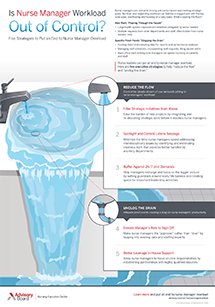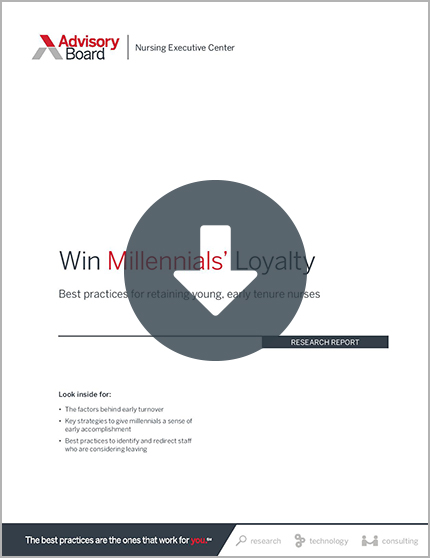Auto logout in seconds.
Continue LogoutEditor's note: This popular story from the Daily Briefing's archives was republished on Jan. 22, 2020.
Nurses often can't find a spare moment in their shifts to take a break, but Harborview Medical Center in Seattle found a way to give its nurses some much-needed rest—leading to better nurse retention and improved patient outcomes.
Get best practices for retaining young, early tenure nurses
No break, big problem
Skipping breaks can be dangerous, both for nurses and patients.
Compared to other professionals, nurses have high rates of on-the-job fatigue, injuries, and burnout. A lack of rest can exacerbate those problems, and overworked, tired nurses are more likely to cause patient harm, Paige Minemyer writes for FierceHealthcare.
Vanessa Patricelli, an orthopedic nurse at Harborview, writes in a STAT News opinion piece that "the solution may appear obvious: Just take a break." But she notes that's easier said than done.
In many cases, hospitals lack adequate staff to cover for nurses who take breaks. And some RNs delay or skip breaks out of concern for patients. "We tend to put our patients' needs first before we sit down, go to the bathroom, or grab a bite to eat," Patricelli writes.
According to Patricelli, a nurse working a 12-hour shift should take at least three 15-minute breaks and have one uninterrupted meal. While many hospitals set a policy to provide those breaks, "the reality of patient demands and short-staffed units means we are lucky to get five minutes to ourselves," Patricelli writes.
How Harborview found time for breaks
Patricelli details how she and her nurse colleagues at Harborview set out to solve "this unsustainable nursing norm."
They surveyed nurses at the hospital and found that, on average, each nurse missed two meals and 10 breaks over a two-week period. Spurred by the data, they worked with their management team to develop a pilot project to address the problem.
Under the six-month pilot, the hospital added four full-time nurses to two of its acute care units, which allowed relief nurses to cover patients while staff nurses took breaks.
After just a few months, nurses on those units reported increased satisfaction and retention. Patient outcomes also improved, with a documented decline in falls and medication errors compared with nursing units using the traditional "buddy system" to cover patients during breaks.
Now, the relief nurses are part of the units' regular rotations.
"We need to consider similar collaborative approaches that keep nurses at the bedside and nursing as a career choice that we want for our daughters and sons to pursue," Patricelli writes. "The future of nursing depends on it" (Patricelli, "First Opinion," STAT News, 9/23; Minemyer, FierceHealthcare, 9/23).
Build a millennial-specific loyalty strategy to retain young, early tenure nurses
In 2016, millennials surpassed Baby Boomers as the largest living generation in the United States. As more millennials have entered the nursing workforce, health care leaders have confronted a growing challenge: young nurses are turning over at higher rates than their older peers, especially early in their careers.
Use the strategies and best practices in this study to build a millennial-specific nurse retention strategy for your organization.
Don't miss out on the latest Advisory Board insights
Create your free account to access 1 resource, including the latest research and webinars.
Want access without creating an account?
You have 1 free members-only resource remaining this month.
1 free members-only resources remaining
1 free members-only resources remaining
You've reached your limit of free insights
Become a member to access all of Advisory Board's resources, events, and experts
Never miss out on the latest innovative health care content tailored to you.
Benefits include:
You've reached your limit of free insights
Become a member to access all of Advisory Board's resources, events, and experts
Never miss out on the latest innovative health care content tailored to you.
Benefits include:
This content is available through your Curated Research partnership with Advisory Board. Click on ‘view this resource’ to read the full piece
Email ask@advisory.com to learn more
Click on ‘Become a Member’ to learn about the benefits of a Full-Access partnership with Advisory Board
Never miss out on the latest innovative health care content tailored to you.
Benefits Include:
This is for members only. Learn more.
Click on ‘Become a Member’ to learn about the benefits of a Full-Access partnership with Advisory Board
Never miss out on the latest innovative health care content tailored to you.


